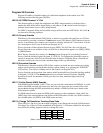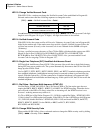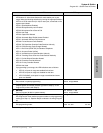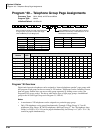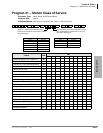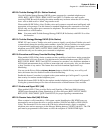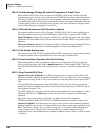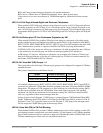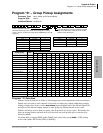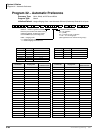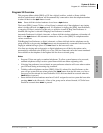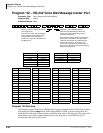
System & Station
Program 31 – Station Class of Service
Strata DK Programming 5/00 3-85
System & Station
LED 20: Toshiba Stratagy/VP (B + Station Number)
Use with Toshiba Stratagy/Stratagy DK/VP systems connected to a standard telephone port
(PSTU, RSTU, RSTU2, PESU, RDSU, KSTU2 and QSTU2). Toshiba voice mail systems
receiving DTMF B tone followed by the station number may not know where the call is coming
from - such as hold recall or “blind” ring transfer recall.
When enabled (LED 20 On), allows Toshiba voice mail systems to respond more intelligently with
appropriate voice prompts. Use this feature for standard telephone ports connected to voice mail
devices only, not for station ports connected to telephones. The station number is not returned, it
blind transfers to a DND station.
Note You must enable Toshiba Stratagy/Stratagy DK/VP (B No Station) with LED 19 to allow
this function.
LED 19: Toshiba Stratagy/Stratagy DK/VP (B No Station)
DTMF “B” tone is sent to Toshiba voice mail systems to signify a recall where Toshiba voice mail
systems already knows the recalling station number. Again, this allows Toshiba voice mail systems
to respond more intelligently with appropriate voice prompts. Use this feature for standard
telephone ports (PSTU, RSTU, RSTU2, PESU, RDSU, KSTU2 and QSTU2) connected to voice
mail devices only, not for station ports connected to telephones.
LED 18: Executive and Privacy Override Blocking (Modem)
When enabled (LED 18 On), denies a station user the capability to break into a station connection
with Executive or Privacy Override. Use this feature for standard telephone ports (PSTU, RSTU,
RSTU2, PESU, RDSU, KSTU2 and QSTU2) connected to a modem, voice mail/auto attendant or
ACD digital announcement device in order to ensure data and voice security. Also, use this feature
to deny override of any station. This feature does not block Attendant Supervised Loop
Monitoring.
You can use the Privacy Release
3ULYDF\5HOHDVH button to disable Privacy on a call-by-call
basis; this button does not disable Executive Override Blocking.
Enable this feature if a modem is assigned to the system modem pool in Program 21 to provide
data security for modem standard telephone ports.
Disable this feature (LED 18 Off) for the modem standard telephone ports assigned in Program 21
if using the system modem pool for data calls that must be switched between voice and data.
LED 17: End-to-end Signal RCV (VM)
When enabled (LED 17 On), provides End-to-end Signaling of Dual-tone Multi-frequency
(DTMF) tones through the system. Required on all voice mail ports (RSTU, RSTU2, RDSU/
RSTS, PSTU, PESU, RDSU, QSTU2 and KSTU2) for proper signaling communication.
LED 16: Receive Voice Mail (VM) ID Code
When a station is call-forwarded to a VM system, certain identification (ID) DTMF tones are
automatically sent to direct the call to a specific mailbox (VM ID Code #656 or DNIS VM ID
Code). The automatic ID is also sent to the VM device when electronic, digital, or standard
telephone users retrieve messages via the Message Waiting buttons (VM ID Code #657). The VM
port must be programmed for this feature to allow the reception of VM ID DTMF digits.



